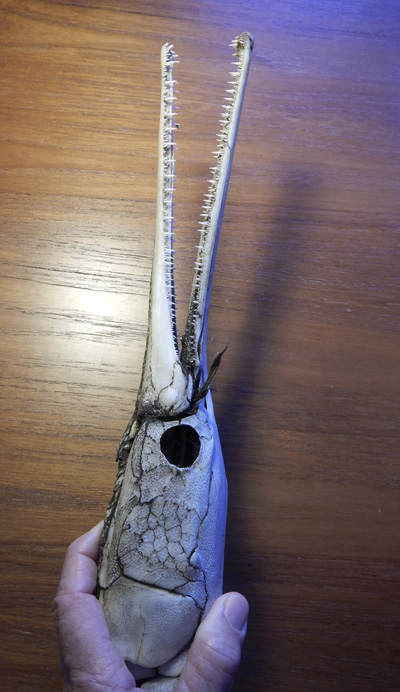Published in the Ocean Watch column, Honolulu Star-Advertiser © Susan Scott
March 10, 2014
I spent the last New Year’s holiday with friends at their lake house near Austin, Texas. Due to prolonged drought, the water level in this man-made lake, created by damming a river in 1938, was so low that a good part of it was bone-dry. We didn’t let that stop the fun. Instead of boating on Lake Buchanan’s surface, we hiked across its dirt floor.
I never imagined that while walking to a former island across a desiccated Texas lake bed that I would discover a fish completely new to me, but that’s the fun of traveling. The lake had gars.
 This Texas gar was gifted to Susan Scott.
This Texas gar was gifted to Susan Scott.
©2014 Susan Scott
Gars are living fossils, unchanged for more than 100 million years. My fish textbook calls them relict fish, creatures from earlier eras that have persisted to this day. These hardy fish survive because they’re big, they have heavy scales that act like armor and, when push comes to shove, they can breathe air.
Inside their bodies, gars have a bladder they can fill with air by gulping at the surface. When its water is warm or polluted, and thus low in oxygen, the fish breathes from this air-filled bladder.
Gar fossils have been found throughout the world, but today the seven species of gars that remain are found only in North and Central America. Most gars live in fresh water, but they are also found in brackish estuaries and near oceanic coasts.
The largest of these prehistoric predators grow to monstrous sizes: 6 feet long and up to 300 pounds. Depending on species, gars live for 20 to 50 years.
The name “gar” comes from an Anglo-Saxon word meaning “spear.” This is apt, given the fish’s snout, a ferocious-looking lance filled with short, sharp teeth.
Gars eat fish. The predator drifts motionless near the surface waiting for prey to swim close. With a sideways strike, the gar nabs the fish with its needlelike teeth. Yet even with all those sharp teeth and bulky bodies, no attack on a human has ever been recorded.
Gars are edible, but they’re so bony few people eat them. Anglers fish for gars because they put up fierce fights when hooked.
Once abundant in their native ranges, the ancient gars are scarce today due to dams and fishing pressure. In certain areas some species are now protected.
I didn’t find any gars on my hike, but my friend Greg had found several gar skeletons during his lake bed walks and displayed them on his back porch.
I had nearly forgotten about gars, but last week a large box arrived on my doorstep. Remembering how I admired his gar skulls, Greg sent me one.
Not many people would appreciate getting a fish head in the mail, but I sure did. My new desk decoration is a fine gift from a thoughtful friend.